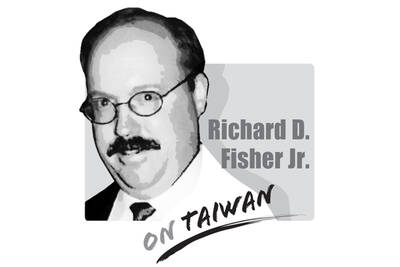Most Chinese provinces and especially the Yangtze River basin have been hit by floods, and as a result, grain shortages are likely to occur in the country this year.
Despite this, Chinese President Xi Jinping (習近平), who wants to be personally in charge of everything, has disappeared from sight for quite a while.
The other six members of the Chinese Communist Party (CCP) Politburo Standing Committee have also disappeared, and Chinese media broadcast little coverage of the floods before Chinese Premier Li Keqiang’s (李克強) inspection of the situation in Guizhou Province on July 6.
Guizhou has been hit by the floods much less than other provinces, so why did Li choose Guizhou? The answer is complicated.
In July 2017, then-Chongqing party secretary Sun Zhengcai (孫政才) was abruptly replaced by then-Guizhou party secretary Chen Miner (陳敏爾), who was reportedly promoted for his outstanding poverty alleviation work in the province. Soon after taking up the post, Chen was appointed to the politburo, and has since not hidden his ambitions to succeed Xi.
Under the plan of Xi’s predecessor Hu Jintao (胡錦濤), Li was to take over as president, and politburo member Hu Chunhua (胡春華) was to succeed Li.
Unfortunately, former president Jiang Zemin (江澤民) and former vice president Zeng Qinghong (曾慶紅) jointly blocked Li by handing power to Xi, who then replaced Sun with his supporter Chen, which must have alarmed Hu Chunhua, who is now only vice premier and might be dumped any time.
Given Xi’s performance in the past few years, the calls for him to step down have grown stronger. Who is likely to take over the leadership if he really loses power? Hu Chunhua seems to be the most qualified. After he had to yield his spot in line to be president, Hu Chunhua might find ample support among those who oppose Xi.
On April 21, CCP mouthpiece People’s Daily Online reported on corruption in the coal mining industry over the past 20 years in the Inner Mongolia Autonomous Region and that nine officials have been investigated. Hu Chunhua was party secretary in the region from 2009 to 2012 and might become the target of an “anti-corruption” crackdown.
As things have progressed to this point, Hu Chunhua will not sit and wait for his death sentence. According to reports from Hong Kong media, he has become increasingly active. Since April, he has visited 13 Chinese provinces, cities or regions despite the COVID-19 outbreak, as if he is preparing to take over from Xi.
Obviously, Li’s inspection in Guizhou was an attempt to dig up dirt on Chen. Following Li’s visit, a video about Dushan County — an impoverished region in Guizhou — borrowing 40 billion yuan (US$5.7 billion) for “vanity projects” went viral on WeChat and other Chinese online platforms. Some of these projects are stunningly luxurious while others are left unfinished. The video is clearly targeting Chen.
Everything from uncovering the various problems in Guizhou to Hu Chunhua’s unexpected activities implies that a severe power struggle could be expected at the annual meeting of the CCP leadership at Beidaihe, which is to take place from late this month to early next month.
Xi’s plan to remain president for life might be in jeopardy as the battle between the two crown princes is becoming apparent.
Paul Lin is a political commentator.
Translated by Eddy Chang

On Sept. 3 in Tiananmen Square, the Chinese Communist Party (CCP) and the People’s Liberation Army (PLA) rolled out a parade of new weapons in PLA service that threaten Taiwan — some of that Taiwan is addressing with added and new military investments and some of which it cannot, having to rely on the initiative of allies like the United States. The CCP’s goal of replacing US leadership on the global stage was advanced by the military parade, but also by China hosting in Tianjin an August 31-Sept. 1 summit of the Shanghai Cooperation Organization (SCO), which since 2001 has specialized
The narrative surrounding Indian Prime Minister Narendra Modi’s attendance at last week’s Shanghai Cooperation Organization (SCO) summit — where he held hands with Russian President Vladimir Putin and chatted amiably with Chinese President Xi Jinping (習近平) — was widely framed as a signal of Modi distancing himself from the US and edging closer to regional autocrats. It was depicted as Modi reacting to the levying of high US tariffs, burying the hatchet over border disputes with China, and heralding less engagement with the Quadrilateral Security dialogue (Quad) composed of the US, India, Japan and Australia. With Modi in China for the
A large part of the discourse about Taiwan as a sovereign, independent nation has centered on conventions of international law and international agreements between outside powers — such as between the US, UK, Russia, the Republic of China (ROC) and Japan at the end of World War II, and between the US and the People’s Republic of China (PRC) since recognition of the PRC as the sole representative of China at the UN. Internationally, the narrative on the PRC and Taiwan has changed considerably since the days of the first term of former president Chen Shui-bian (陳水扁) of the Democratic
A report by the US-based Jamestown Foundation on Tuesday last week warned that China is operating illegal oil drilling inside Taiwan’s exclusive economic zone (EEZ) off the Taiwan-controlled Pratas Island (Dongsha, 東沙群島), marking a sharp escalation in Beijing’s “gray zone” tactics. The report said that, starting in July, state-owned China National Offshore Oil Corp installed 12 permanent or semi-permanent oil rig structures and dozens of associated ships deep inside Taiwan’s EEZ about 48km from the restricted waters of Pratas Island in the northeast of the South China Sea, islands that are home to a Taiwanese garrison. The rigs not only typify